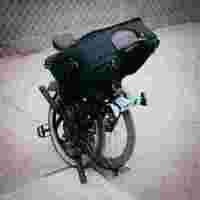UK’s first shared e-cargo bike scheme launches in London
This article was originally published by Christopher Carey on Cities Today , the leading news platform on urban mobility and innovation, reaching an international audience of city leaders. For the latest updates, follow Cities Today on Twitter , Facebook , LinkedIn , Instagram , and YouTube , or sign up for Cities Today News.

The UK’s first public e-cargo bike-sharing scheme is being launched in east London this month to help residents and businesses move goods using low-carbon transport.
Eight new electrically assisted cargo bikes, each capable of carrying up to 80kg, will be available to rent from four docking stations across the borough of Hackney.
The scheme is funded by the Mayor of London and the tri-borough Zero Emissions Network , which helps residents and businesses in Tower Hamlets, Islington and Hackney save money, reduce emissions and improve local air quality.
Councillor Mete Coban, Hackney Borough Council’s Cabinet Member for Energy, Waste, Transport and Public Realm, said: “Cargo Bike Share is a nationwide first, and is one of the many ways we’re working to rebuild a greener Hackney in the aftermath of the pandemic – with cleaner air, healthier lives and better neighbourhoods for all of our residents and businesses.”
The bikes will be available to hire through the Beryl app and docking stations are being installed this month.
Beryl Chief Executive Philip Ellis said: “For last-mile deliveries or short journeys, e-cargo bikes are by far the best and often the most time-efficient way to move large or heavy items.
“By replacing vans, a network of e-cargo bikes has the potential to transform local areas making them safer and more pleasant to live and work in.”
Velo-city 2021
Efforts to move more Europeans onto two wheels have stepped up in recent years, with more cities investing additional time and money in cycle-related projects.
Speaking at the Velo-city 2021 conference in Lisbon last week, Jill Warren, CEO of the European Cyclists’ Federation, said: “It cannot be said enough: there is no conceivable way to achieve the sustainable development goals, the European Green Deal or climate-neutral cities without significantly more cycling.”
The four-day conference, held both in-person and digitally, brought together cycling experts from all over the world to discuss the latest trends in the industry.
On the sidelines of the event, Brussels Minister of Mobility Elke Van den Brandt received an award for the promotion of cycling from the Cycling Embassy of Denmark, after unveiling a plan to triple the use of bicycles by the city’s residents by 2030.
“I am very honoured to receive this prize,” said Van den Brandt.
“It’s a prize I share with the many thousands of Brussels residents who choose an alternative and thus join the fight against air pollution and car pressure in our city.”
Do EVs excite your electrons? Do ebikes get your wheels spinning? Do self-driving cars get you all charged up?
Then you need the weekly SHIFT newsletter in your life. Click here to sign up.
Can your EV be hacked? Researchers say yes
As EVs and semi-automated vehicles are becoming a bigger part of our lives, cybersecurity concerns are growing.

Just a year ago, the Autopilot of the Tesla Model X was hacked, and not just once.
In one instance, Israeli researchers at Ben Gurion University tricked the car by flashing “phantom” images on a road, wall or sign, causing it to unexpectedly brake or steer in the wrong direction.
A few months later, Lennert Wouters, a researcher at KU Leuven, “stole” a Tesla Model X in 90 seconds, Wired reported.
Having spotted a vulnerability in its keyless entry system, he only needed $300 in computer hardware items, including a Tesla body control module from eBay, and some coding.
Indeed, automated electric cars are much more prone to hacking than conventional internal c ombustion engine vehicles, according to a new research paper , led by University of Georgia scientists.
Their powertrain consists of multiple complex and integrated cyber-physical systems that require constant monitoring and control, to ensure safety.
Tools such as adaptive cruise control and auto-assist functions are parts of a networked infrastructure, which can be potentially accessed by third parties.
The same goes for the vehicles’ increased connectivity through charging points and smart grids.
Similarly, their enhanced infotainment systems allow for higher levels of exposure.
Jin Ye, the lead author, advises owners of automated EVs to keep in mind the following main signs:
Damaged speed and/or acceleration.
Low percentage of battery capacity in a very short time.
These problems, of course, pose serious safety and functionality issues.
The research suggests some essential techniques to protect such vehicles from cyber-attacks.
Better firewall, reliable hardware, secure software updates, and code reviews make up the majority.
Above all, Ye proposes the development of a cybersecurity monitoring system that will “detect, locate, diagnose, and mitigate cyberattacks.”
“Even though the research of vehicle cyber-security is still at an early stage, and the monitoring system cannot directly recover the system to a safety region, it can alert the driver to react in a timely fashion,” she remarked.
Do EVs excite your electrons? Do ebikes get your wheels spinning? Do self-driving cars get you all charged up?
Then you need the weekly SHIFT newsletter in your life. Click here to sign up
Brompton Electric review: A tiny folding ebike you’ll take almost everywhere
Electric bicycles can be the fastest way to get around a city like New York, but they can also be a pain when you’re not actively using the electric components.

For one, ebikes typically command large price tags that make them compelling targets for thieves; carrying two heavy duty locks with you everywhere is usually a minimum.
For another, they tend to weigh 50-70 pounds, making them a pain to manuever while not riding them. God forbid you need to carry your bike up a fifth floor walkup, or that your bike breaks down and you need to take it on the subway. And good luck going up mild inclines if your battery runs out.
That extra weight often makes storage in an apartment inconvenient too, as you’re unlikely to want to hang one on a wall or vertical bike rack. For all the conveniences of ebikes, they rarely come without significant caveats.
I say all this not to disparage ebikes, which I think are essential for the future of green transportation in cities. But rather, it’s to highlight just how awesome the Brompton Electric is. Able to fold down so small you can bring it almost anywhere, it has all the fun and power of a typical ebike, with none of the above issues.
It’s very pricey, starting at $3499, but it’s hard to put a price on some of the conveniences and peace of mind it affords you.
I’ve ridden several folding bikes before, but none that fold down nearly as compact. This is thanks to 16″ tires (most folding bikes use 20″ tires) a clever three-part frame (most folding bikes just have a frame split down the middle), and an easily-removable cargo bag which contains the battery. The Brompton Electric is just 22.2″ x 23″ x 10.6″ (565 x 585 x 270mm) when folded. That’s just a little wider than an overstuffed carryon bag, and visually the footprint is a even smaller.
Here’s how the fold works:
Because the battery bag is meant to be removed when bringing the bike indoors, the 6-speed option I reviewed weighs just 32 lbs, less than the superlight Specialized Turbo Vado SL I reviewed a few months ago. Granted, the battery bag adds another ~7 lbs, but you hardly feel it as the bag is meant to be strapped around your shoulder when not riding the bike. Even the combined weight is less than the vast majority of ebikes on the market, and the two-speed option shaves off another couple of pounds.
By comparison typical electric folding bikes tend to hover around 35″ x 28″ x 17″ and 50-60 lbs, let alone some popular fat-tire models. Moreover, Brompton’s folding mechanism has been largely unchanged since the bikes were introduced in the 70s; the company built its reputation on the compactness and durability of its fold.
On paper, the Brompton Electric’s folded size may not seem like that much of a big deal, but it made a dramatic impact on my riding (and peace of mind). It’s small enough that I opt to always keep it in my small apartment rather than the storage room where the rest of my review bikes are. Moreover, in two months and hundreds of miles of riding three or four days a week, I’ve never had to lock up the bike. The only time I did lock it up was just to test where I’d fit the U-lock if I had to (some tips in this video ).


To give you an idea, here are some of the places I’ve taken the bike indoors:
For groceries, the most common scenario. While the bike can actually roll on wheels attached to the fenders (more on this later), I preferred to simply stick the bike in the shopping cart.
To get several Covid-19 tests
To go to the doctor for a physical
When grabbing a coffee or food for pickup
Going on essential shopping trips
On the subway and in cabs
For regular visits to my mom in the hospital
That last one is particularly important, and it made me appreciate the Brompton Electric in a more meaningful way than any other product, let alone ebike, that I’ve tested.
Shortly after I before I began reviewing the Brompton Electric, my mom was admitted to the hospital for what turned out to be cancer; she is still at the hospital as of publishing this review.
I’d spent almost all of the coronavirus pandemic minimizing trips outside my neighborhood and avoiding public transportation at all costs; I’ve been lucky enough to not be infected so far. But suddenly I had to visit my mom multiple times a week, spending several hours a day at the hospital.
That’s too often and too long to be comfortable locking up any of the other ebikes I’ve tested outside. Even the other folding bikes I’ve tested would simply be too big to bring into the hospital.
But no one ever batted an eye when I rolled in the Brompton, other than to occasionally ask what it was. Being able to ride the bike to and from the hospital 10 miles away helped minimize my exposure to the virus, and by extension that of others around me. And on the days when I was too tired or was met with a sudden rain, I could just stick it in a cab or bring it with me on the subway.
The personal impact of the Brompton during my review period creates an obvious bias, but that doesn’t make my experiences any less true. It’s a kind of peace of mind you just can’t get with almost any other ebike — other folders included.
I’ve spent a lot of time talking about the bike’s compact size because that really is its primary selling point. But of course, that wouldn’t matter much if the bike sucked otherwise. Thankfully the Brompton Electric also happens to be joy to ride.
While I had concerns about how the small wheels would fare in city streets, they were unfounded. The little tires handle the poorly kept city streets fine. If anything, the bike is a little more comfortable than some full-size ebikes thanks to the suspension block built into the rear folding mechanism. Meanwhile the Schwalbe Marathon Racer are more durable than most stock tires (and if you get a flat, just pop the bike in a cab!).
The bike’s 3-way folding frame and extra-long seatpost feel just as solid as any normal bike, and the rim brakes have good enough stopping power that I didn’t miss the disk brakes available on most other ebikes. And mind you, I’m 6 feet tall, I’m technically a hair over the Brompton’s stated weight limit of 242lb, and on top of that I regularly load the bike with dozens of pounds of cargo.
Granted, it’s only been two months, but the Brompton Electric feels like it’s truly built to last for decades. I can’t speak to the durability of the electric components, but you can find Bromptons over 10 years old selling for well over a thousand bucks online.
Speaking of cargo, I initially thought having a separate battery bag would be an inconvenience, but I ended up appreciating always having some cargo ability on the Brompton electric. I opted to try the larger ‘City’ bag (unfortunately, a $200-ish addon), which has enough room for a small impromptu grocery trip, especially if you keep an extra bag or two in one of the side pockets. The default smaller bag really only has room for a phone and a couple of other doodads.
The biggest caveat for many potential riders will be the Brompton Electric’s speed: it’s limited to about 16 miles per hour. Most ebikes do at least 20 mph in the States.
I didn’t really mind, especially considering the small battery and minimal weight. It means I can get about 25+ miles mostly riding on level 2 despite my weight (obviously, you’ll get more range as a lighter rider). And the bike is so light that it’s still a joy to ride if the battery runs out (or again, take the lazy route and plop it in a cab). In any case, acceleration is still incredibly zippy, thanks in part to the small wheels, and the torque sensor means the motor nicely matches your pedaling effort. It’s just not the type of ebike you use to challenge motorcycles.
Some other miscellaneous notes:
The folding mechanism definitely has a bit of a learning curve, as there are more steps than the usual folding bike, but once you get the hang of it, folding and unfolding takes about 30-50 seconds. It’s also immensely satisfying (and you can do it a lot faster with practice).
Although I haven’t hadn’t had to lock the bike outside so far, there are a few scenarios where you might. Once the pandemic is over, I imagine you won’t be able to bring the bike into a movie theater. You might not want to bring it into a fancy restaurant after a rainstorm either. So you should still have a heavy duty lock.
As a rule of thumb, I’d say it’s probably fine most places you’d be able to bringing a carry on-sized suitcase.
The battery has a USB-A port for charging your phone or whathaveyou.
The 6-speed model I tested involves a combination of a derailleur and internally geared hub — meaning you need use two shifters to go through the full range or gear ratios. This also takes some getting used to.
The built in lights are bright, with a nice beam pattern on the headlight.
There’s no throttle. This is an ebike you have to ride like a bike.
While the bike is small enough to bring on a plane easily, the battery is too big to be allowed on flights. Still, you can ride it in analog mode if you wish.
The power and headlight controls are built into the battery, which means it’s a bit awkward to change these settings while riding. There’s also no screen to provide an odometer or speedometer
Unfortunately, there are currently only two bag sizes compatible with the Brompton Electric’s luggage block. The standard Brompton has far more (and far larger) cargo accessories.
The bike comes with Schwalbe Marathon Racers, which are pretty nice tires, but I would’ve rather seen the more durable Marathon Greenguards or Marathon Plus’ (AKA I’m complaining about the one flat I had during my ride).
I’m a big fan of the electric blue of my review unit, though it also comes in white, black, and a dark blue lacquer.
The bike can be a little awkward to roll around when folded on rough roads as the fender wheels are quite small and lateral balance is a little precarious. There are third party accessories that can greatly remedy this, but I wish Brompton would address this itself.
There’s no kickstand included, but you can just fold the rear wheel to keep it upright.
Brompton offers a Quadlock phone mount which fits in the handlebars and allows the bike to fold normally, although it requires your phone use a special case.
People will ask you a lot of questions about this bike.
It’s hard to overstate the impact of the Brompton Electric’s compact fold and featherweight status, epecially for a city dweller.
It’s the difference between having to find somewhere to lock up your bike and then stressing about it the whole time, or arriving at your destination knowing your expensive investment is as safe as can be. It means you’ll take your bike almost everywhere you can, as opposed to having to carefully planning which trips are better for and which are better for other methods of transport.
Yes, the Brompton Electric is expensive enough that you can buy some used cars for the price —especially with upgrades and accessories — but for many city dwellers that isn’t an option (not to mention a car has far higher long-term costs). It may not be the fastest, smoothest, or longest-lasting ebike I’ve reviewed, but it is without a doubt the one I have most enjoyed riding. That’s in no small part due to never worrying about locking up, but also because it’s so darn fun to ride. If you can afford its hefty price tag, the Brompton Electric is an absolute joy.
SHIFT is brought to you by Polestar. It’s time to accelerate the shift to sustainable mobility. That is why Polestar combines electric driving with cutting-edge design and thrilling performance. Find out how .